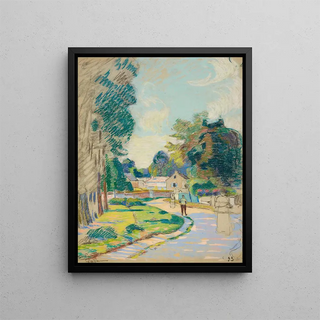Art print of a street in Île-de-France - Armand Guillaumin


View from behind

Frame (optional)
In the world of art, some works transcend their era to capture the essence of a place and a moment. "Une rue en Île-de-France" by Armand Guillaumin is one of those creations that transports us to the heart of 19th-century Parisian life. The scene depicted by the artist evokes a vibrant atmosphere, where light plays a crucial role, illuminating the facades of buildings and revealing subtle nuances of the surrounding nature. This piece, both simple and complex, invites us to explore the streets of the French capital through the eyes of an impressionist master, whose sensitivity and unique perspective on the world still move us today.
Style and uniqueness of the work
Armand Guillaumin's style is characterized by a bold use of color and light, hallmarks of Impressionism. In "Une rue en Île-de-France," the quick and energetic brushstrokes create a lively, almost tangible texture that brings the scene to life. The composition, though relaxed, reveals meticulous attention to detail, from the shadows cast by the buildings to the reflections in the wet cobblestones. The color palette, with its warm and luminous hues, evokes a sense of warmth and conviviality, inviting the viewer to feel the beauty of a frozen moment in time. Guillaumin manages to capture not only the visual aspect of the street but also its atmosphere, its dynamics, and its history, making this work a living testimony of urban life.
The artist and his influence
Armand Guillaumin, though less known than some of his contemporaries, played a crucial role in the development of Impressionism. Born in 1841, he established himself as an innovative artist, exploring themes of nature and daily life with a unique sensitivity. His relationship with iconic figures like Claude Monet and Camille Pissarro undoubtedly enriched his artistic journey, but it is his own vision that allowed him to stand out. Guillaumin often painted landscapes and scenes of Parisian life, offering a personal and emotional perspective on modernity that

Matte finish

View from behind

Frame (optional)
In the world of art, some works transcend their era to capture the essence of a place and a moment. "Une rue en Île-de-France" by Armand Guillaumin is one of those creations that transports us to the heart of 19th-century Parisian life. The scene depicted by the artist evokes a vibrant atmosphere, where light plays a crucial role, illuminating the facades of buildings and revealing subtle nuances of the surrounding nature. This piece, both simple and complex, invites us to explore the streets of the French capital through the eyes of an impressionist master, whose sensitivity and unique perspective on the world still move us today.
Style and uniqueness of the work
Armand Guillaumin's style is characterized by a bold use of color and light, hallmarks of Impressionism. In "Une rue en Île-de-France," the quick and energetic brushstrokes create a lively, almost tangible texture that brings the scene to life. The composition, though relaxed, reveals meticulous attention to detail, from the shadows cast by the buildings to the reflections in the wet cobblestones. The color palette, with its warm and luminous hues, evokes a sense of warmth and conviviality, inviting the viewer to feel the beauty of a frozen moment in time. Guillaumin manages to capture not only the visual aspect of the street but also its atmosphere, its dynamics, and its history, making this work a living testimony of urban life.
The artist and his influence
Armand Guillaumin, though less known than some of his contemporaries, played a crucial role in the development of Impressionism. Born in 1841, he established himself as an innovative artist, exploring themes of nature and daily life with a unique sensitivity. His relationship with iconic figures like Claude Monet and Camille Pissarro undoubtedly enriched his artistic journey, but it is his own vision that allowed him to stand out. Guillaumin often painted landscapes and scenes of Parisian life, offering a personal and emotional perspective on modernity that
12,34 €






